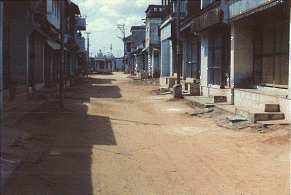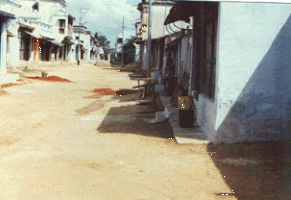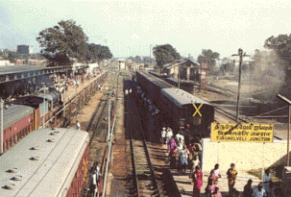Kizhanatham Family Tree
According to a legend, supported by historical facts, Kizhanatham village was founded after the previous village (Vellakoil) was totally destroyed by massive floods of the Tambiravarni river in 1760s. The overflow from the river caused massive destruction of property and human lives. However, two families were able to survive the catastrophic floods because they were able to climb up the palm trees and stay up until the floods completely receded. These two families are considered the founders of Kizhanatham village. During its 200-year plus history, the village, its people, and their occupational structure have undergone profound transformation. The village has not changed in one sense in its entire history: It was and still is a one-street village containing approximately 80 houses as the following pictures illustrate:


Photographs of Kizhanatham village
Nearly forty years ago, the village got electricity, a post office (with telephone facilities), and bus service between the village and nearby cities (Palayamkottai and Tirunelveli). Tirunelveli serves as the district (similar to the American county) headquarters and has a major railroad station with connections to all parts of the country.

It has been well established that the founders of Kizhanatham village were not natives of this area, but came from another village (Velamur) 300 miles north of Kizhanatham village. What prompted them to move south is not known. It was common for families to go on pilgrimages to far-off places (several hundred miles away) by slow means of transportation before the railroad system was introduced. Such trips took several months and resulted in unplanned relocation of families due to family circumstances or personal choice. For example, our grandmother (mother’s mother) came from a family that settled down in the state of West Bengal (1600 miles from our village) two generations earlier and was reared in a different cultural and linguistic milieu.
It is interesting to note, however, that the relocation of families does not alter the practice of referring to one’s geographical origin long after the event has faded from one’s memory. Our father was intrigued by the fact that Kizhanatham village family wedding invitations referred to Velamur (the original village of origin) and the name was also invoked in ancestral worship. His research led to the discovery that such a village not only existed in reality, but the people of that village predominantly belonged to the same caste and the Vedic group (Sama) as those of our village. Similarly, the generations which followed my father’s most likely refer to their village of origin as Kizhanatham, although they may have been born and raised in major cities of India such as Bombay, Calcutta, or New Delhi, or outside of the country and may have never seen the village. Despite the inroads of industrialization and urbanization, the village in India continues to serve as the source of identification.
Until the middle of the twentieth century, the families of Kizhanatham village had modest landholdings which were leased to farmers for cultivation. Men were usually literate and women were less so. By the middle of the nineteenth century, with the consolidation of British rule in the country and the establishment of an educational system which offered opportunities for the completion of high school, the career goal of young men in our father’s generation was to obtain clerical jobs with the state government or the railroads built and operated by a British company. This was the beginning of the abandonment of traditional education which prepared young men for a priestly order and the choice of western education for employment in the British colonial bureaucratic system.
Our grandfather was the last priest (follower of Sama Veda) who came from a long, unbroken line of priests and performed ceremonial duties covering such events as births, marriages, and deaths in the village and beyond. The chain was broken by our father’s generation when he and his two younger brothers finished high school and took up jobs with the private sector. Our father’s older brother completed four years of college and obtained teaching accreditation and became a teacher of mathematics. Our uncle (our father’s older brother) was a well regarded mathematics teacher in St. Xavier’s High School for approximately 35 years. He authored several textbooks in mathematics and trained hundreds of students during his teaching career.
The generations which followed our father’s have chosen and excelled in diverse occupational fields: science, engineering, journalism, law, medicine, computer technology, teaching, business, etc. etc. They are dispersed throughout India and other parts of the world. Our father’s dream was to trace our family roots and their branches through a recorded system which will perpetuate the historical legacy and serve as a psychological source of identification for the current and future generations of men and women who can trace their origins to the village.